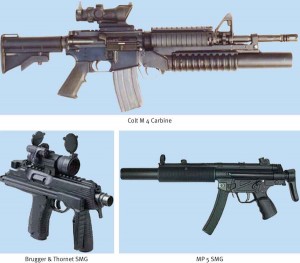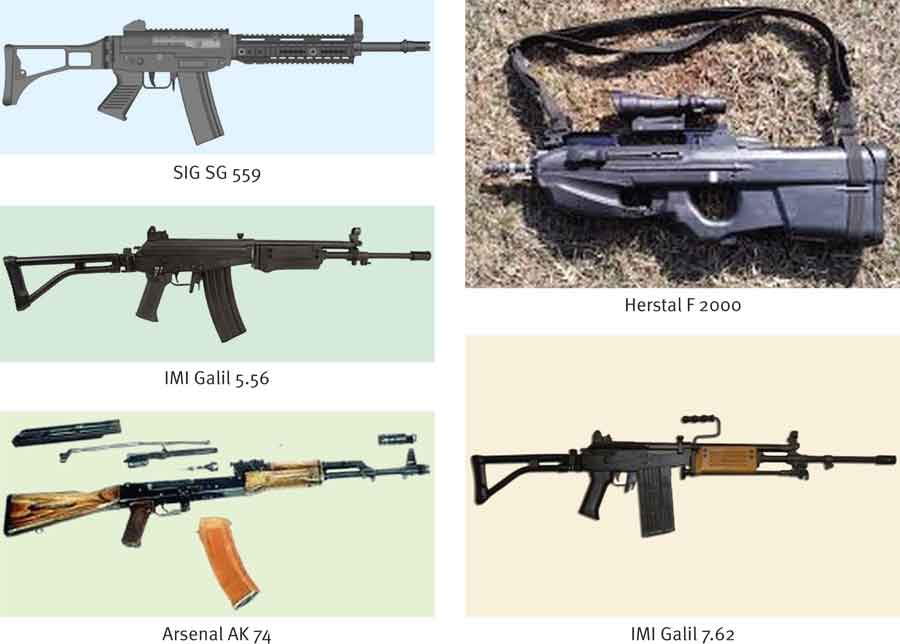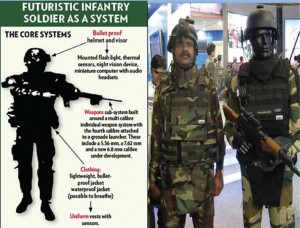The uniform will also carry solar chargers for palmtops and other attached electronic equipment. It will contain external oxygen supply and respirator providing protection against gas and smoke and will include flame retardant carbonised viscose undergarments, fire-proof knee and elbow pads, bullet-proof armoured waistcoat designed to stop a bullet, ceramic armour plates covering the front, back and groin and an armoured helmet capable of stopping a 9mm round at close range. The new uniform will have vests with sensors to monitor the soldier’s health parameters and provide quick medical relief.
The Battlefield Management System (BMS) and F-INSAS programs are being developed concurrently…
The weapons sub-system is being built around a multi-caliber individual weapons system with the fourth caliber attached to a grenade launcher. These include a 5.56 mm, a 7.62 mm and a new 6.8 mm under development for the first time in India. The Under Barrel Grenade Launcher (UBGL) will be capable of launching air bursting grenades. The sub-system includes a thermal weapon sight and laser range finder to provide the soldier with range and direction information.
The Global Positioning System (GPS) location information will allow the soldier to call for indirect fire accurately. Assault rifles and carbines are being imported, as mentioned above. As for accessories, soldiers will be equipped with Palmtop GPS device for communicating with other soldiers and locate or generate maps to find location and for situational awareness. The palmtop will inform the soldiers of the location of friendly forces in relation to their own positions. It will also enable them to transfer messages. Terrain equipment gears for various specific missions will also be carried. Thermal imaging, sensors and night vision equipment will be customised to make them portable. Advanced GPS receivers, infra-red sensors, thermal sensors, electro-magnetic sensors and radio frequency sensors would also be carried.
The Battlefield Management System (BMS) and F-INSAS programs are being developed concurrently; the BMS under Information Systems and F-INSAS under the Infantry. The BMS was conceived at battalion/regiment level pan army (including for the infantry) and comprises communication, non-communication hardware and software. The lowest level to which the system will be connected is the individual soldier/weapons platform and the highest level with the Battalion/Regiment Commander. The system will be further integrated with the Tactical Command, Control, Communications and Information (TAC C3I) System through the Command Information Decision Support System (CIDSS). The Directorate General of Information System (DGIS) is charged with facilitating transformation of the IA into a dynamic network-centric force, achieving information superiority through effective management of information technology.
 Quite logically, Phase III of the F-INSAS (Computer Sub System, Radio Sub System, Software and Software Integration) should have been part of the BMS, especially since the latter also caters for Mechanised Infantry both in mounted and dismounted roles. Squabbling over delimitation between the BMS and F-INSAS cost delays to Phase I of BMS by almost one year. Since F-INSAS is to incorporate situational awareness and GIS, it amounts to not only ‘re-inventing the wheel’ but will require yet another project to integrate the F-INSAS with the BMS implying infructuous and avoidable additional expenditure and time.
Quite logically, Phase III of the F-INSAS (Computer Sub System, Radio Sub System, Software and Software Integration) should have been part of the BMS, especially since the latter also caters for Mechanised Infantry both in mounted and dismounted roles. Squabbling over delimitation between the BMS and F-INSAS cost delays to Phase I of BMS by almost one year. Since F-INSAS is to incorporate situational awareness and GIS, it amounts to not only ‘re-inventing the wheel’ but will require yet another project to integrate the F-INSAS with the BMS implying infructuous and avoidable additional expenditure and time.
Why the Army and CAPF are resorting to imports is simply because the indigenous weapons are sub-standard; a situation where the terrorists and insurgents have better arms is unacceptable. That we are unable to produce state-of-the-art individual small arms should be a matter of shame for the DRDO, Ordnance Factories Board (OFB) and the MoD under whom both these bodies are directly placed, as also the Defence Minister as one of the longest serving Defence Ministers. Ironically, the MoD has failed to usher in accountability into these organisations and they continue to remain lackadaisical in meeting the demands of national security despite the crores consumed annually by these establishments.
The Government must sincerely overhaul the DRDO, OFB and the PSUs by bringing in accountability…
Requirements
The Government must sincerely overhaul the DRDO, OFB and the PSUs by bringing in accountability and making them more focused. Clear directions must be given about what is required to be done laying down strict timelines. A system of roll on development, monitoring, periodic checks, feedback and mid-course corrections is needed. A Weapons, Equipment and Technology Development Roadmap on a 15 to 20 year basis is required and appropriate R&D allocations are warranted. This must include specific measures for leapfrogging technology and should be made known to indigenous private industry well in advance. Although dialogue between MoD, Military and DRDO-OFB-PSUs is institutionalised, same is not the case between the MoD-Private Industry-users (Military). Open and periodic dialogue between MoD-Private Industry-users (Military) is essential to ascertain why the Private Industry is resentful of the existing framework and DPP.
The annual review of the DPP must incorporate Private Industry participation in the review process itself. Having intimated the Weapons, Equipment and Technology Development Roadmap to the Private Industry well in advance, a feedback must be instituted (perhaps through organisations such as the CII and ASSOCHAM) to ascertain which Private Industry or Conglomerate of Private Industries are prepared to take on weapons, equipment and/or technology. Considering the load of the DRDO-OFB-PSUs, the Government should actually bifurcate the products to be developed by the private sector and by the PSUs. Banning firms on the first accusation of corruption without alternative sources of procurement is a recipe of disaster that kills modernisation plans. While action against the corrupt is warranted outright banning of firms forces the military to make do with archaic weapons.
Prudence demands that we look beyond the F-INSAS and modernisation of the infantry…
Looking Beyond
Prudence demands that we look beyond the F-INSAS and modernisation of the infantry. Soldiers other than from Infantry also contribute to the ‘cutting edge’ as frontline troops. The BMS is catering for the digitised battlefield at regiment/battalion level pan army but the BMS does not cater for improvements in Weapons, Body Armour, Clothing and Individual equipment, which actually should be part of soldier modernisation pan army. In an environment of counter terrorism and counter insurgency, invariably troops other than infantry also get involved in operations inadvertently or advertently. We should therefore be looking at across-the-board soldier modernisation concurrent to the infantry soldier.
A dispassionate analysis would indicate that the costs involved are miniscule compared to big ticket acquisitions and a minor curtailing of the latter can easily be adjusted against full spectrum soldier modernisation considering the pay offs in terms of enhanced operational efficiency at the cutting edge. Such modernisation should include very basic items for NBC protection such as masks, gloves and helmets.
Considering the heightened unconventional threats that are likely to expand in future, the entire Security Sector needs to be energised. The national cutting edge includes the Para Military Forces (PMF) and CAPF besides others. Therefore, at least those PMF and CAPF units that are engaged or tasked for counter terrorism and counter insurgency must be part of soldier modernisation. In twenty-first century conflict situations not only will operations call for increased inter-agency cooperation but will also involve greater application of ‘all elements of national power’ as our adversaries will employ hi-tech irregular forces against us. If we can achieve soldier modernisation within the Security Sector and network this cutting edge at the national level, we can be sure to win future conflicts.
Conclusion
Infantry modernisation has not received due importance in past decades. This must be treated as an ‘emergent’ requirement in consideration of the emerging threats from within and outside the country and against the backdrop of the level of sophistication being achieved by terrorists and insurgents. India must be prepared for short, intense hi-tech wars, in addition to expanding terrorism, asymmetric and fourth generation wars where the soldier faces the brunt at the cutting edge. Delay in modernisation has a direct bearing on combat efficiency in coping with threats to national security and may cost the lives of the infantrymen.







Most modern infantry with latest weapons to fight who?
China & Pakistan are not the most modern equipped armies. They are even below in equipment compared to India. Their weapon is intimidation with nuclear weapons (Pakistan), better infrastructure in Tibet (China).
You have not made a good point to explain why only 60,000 new rifles to be imported and 100,000 to be made locally. You out of the people know that India has 1.1 million people under arms. You need that many rifles if the existing INSAS has to be replaced. Where are the remaining 900,000 rifles going to come from.
You general out of all the people know that FAL (Ishapore) was a great rifle. It kicked like a mule at 600 to 800 yards. It was big mistake to switch to smaller caliber 5.56 rifle. Excuse given was that a soldier will carry more ammunition in his back pack. How much more – to last another 20 minutes in a long battle. The point here is that a soldier has to be resupplied. The 7.62 or 5.56 does not better. Under the circumstances, If I am soldier I would like to carry 7.62 to kill the enemy in the first shot.
As a matter of fact the generals of 80s & 90s were listening too much of American propaganda. They were switching to M-16 with smaller bullets which inhumanely kills at 400 yards. It does not penetrate but turns inside the body tearing the organs apart. The 7.62 passes thru a man and the next one and kills instantly.
Now the generals of today have realized their great folly (asking for INSAS 5.56mm) and are correcting themselves now by asking for interchangeable barrel. It hides their past mistakes and corrects the problem of range and velocity in the smaller bullet. What an expensive disaster got perpetuated in 90s when smaller bullet 5.56 mm was introduced. Correction is coming now. The generals are asking for bigger barrel and bullet.
incidentally do not listen too much to the Americans. In last 30 years, they fight only close quarter battlers where 5.56 is good. India is different